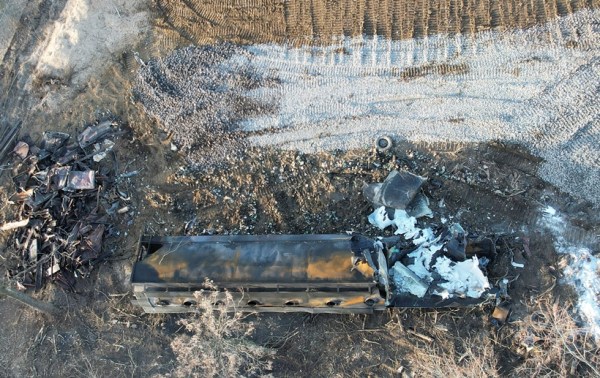Months-Long Lingering Of Toxic Chemicals After Ohio Train Derailment

Table of Contents
The Initial Impact and Immediate Concerns
On February 3, 2023, a Norfolk Southern freight train carrying hazardous materials derailed in East Palestine, Ohio. The immediate aftermath saw a controlled release and subsequent burning of vinyl chloride, a known carcinogen, and other toxic chemicals, including butyl acrylate. This action, while intended to prevent a potentially larger explosion, released plumes of toxic smoke into the air, prompting the immediate evacuation of thousands of residents.
- Chemicals Released: Vinyl chloride (carcinogen), butyl acrylate (irritant), ethylene glycol monobutyl ether (potential reproductive toxin), and others.
- Evacuations and Affected Residents: Thousands were evacuated, and the exact number of individuals directly impacted continues to be debated and investigated.
- Initial Government Response: The initial response was met with criticism from residents and environmental groups, who raised concerns about the speed and effectiveness of the cleanup and the communication with the affected community.
Months Later: Persistent Contamination and Environmental Concerns
Months after the derailment, the presence of toxic chemicals in the environment remains a significant worry. Testing continues to reveal contamination in soil and water samples, raising concerns about long-term environmental damage. The potential for groundwater contamination poses a serious threat to drinking water sources and the local ecosystem.
- Latest Testing Results: While some official reports show decreasing levels of contamination, independent testing and resident reports suggest lingering concerns. Complete and transparent data remains crucial.
- Impact on Wildlife: The effects on local wildlife are still being assessed, with reports of dead fish and other animals in the affected areas. The long-term impact on the ecosystem remains unknown.
- Environmental Remediation: The long-term environmental remediation process is ongoing, but its full scope and effectiveness are still uncertain, necessitating further investigation and transparent reporting.
Long-Term Health Effects on Residents
The potential for long-term health consequences for residents exposed to the toxic chemicals released during the derailment is a critical concern. Reports of various health issues, including respiratory problems, headaches, skin irritation, and other symptoms, have emerged from the community.
- Reported Health Issues: Residents have reported a wide range of symptoms, indicating a potential link to the chemical exposure, but long-term effects are still unknown. Ongoing health monitoring is crucial.
- Ongoing Health Studies and Monitoring: While some health studies have begun, there are concerns regarding their scope and independence. Comprehensive and long-term health monitoring is essential to fully understand the health impact.
- Concerns about Lack of Data: A significant concern revolves around the lack of readily available, comprehensive data on both the environmental contamination levels and the health of the affected population.
The Need for Comprehensive and Transparent Information
The lack of easily accessible and comprehensive information regarding the health impacts of the derailment is unacceptable. Open communication and complete transparency from authorities are critical to rebuild trust and allow residents to make informed decisions about their health and well-being.
- Information Needed by Residents: Residents need detailed information on the long-term health monitoring plans, complete data on environmental remediation efforts, and the precise levels of contaminants found in their environment.
- Calls for Independent Investigations: Independent investigations into both the cause of the derailment and the extent of the contamination are essential to ensure accountability and transparency.
- Concerns about Lack of Accountability: Transparency and accountability are crucial to address public concerns about potential cover-ups or a lack of attention to the long-term implications of the disaster.
Ongoing Cleanup Efforts and Future Prevention
Ongoing cleanup efforts are underway, focusing on soil and water remediation. However, questions about their effectiveness and long-term sustainability persist. Measures to prevent future similar incidents must also be implemented.
- Cleanup Process: The cleanup process involves various methods, including soil removal and water treatment, but the long-term efficacy remains to be seen.
- Evaluation of Cleanup Strategies: A thorough and independent evaluation of the effectiveness of the cleanup strategies is crucial to ensure that the environment is restored to a safe state.
- Future Prevention: Improvements to railway safety regulations, including stricter rules for the transport of hazardous materials, and enhanced emergency response protocols are essential to prevent future derailments and chemical spills.
Conclusion
The months-long lingering effects of toxic chemicals from the Ohio train derailment present a grave and ongoing crisis. The persistent environmental contamination and the potential for long-term health consequences demand continued monitoring, comprehensive cleanup efforts, and complete transparency from all involved parties. We must advocate for stronger regulations, improved safety protocols, and thorough, independent investigations to ensure such a disaster never happens again. Staying informed about the lingering impact of this toxic chemical spill is crucial—let's demand accountability and prevent future occurrences of this devastating type of environmental disaster.

Featured Posts
-
 Podcast Production Revolutionized Ai And The Analysis Of Repetitive Scatological Texts
Apr 22, 2025
Podcast Production Revolutionized Ai And The Analysis Of Repetitive Scatological Texts
Apr 22, 2025 -
 Death Of Pope Francis At 88 Pneumonia Battle Ends
Apr 22, 2025
Death Of Pope Francis At 88 Pneumonia Battle Ends
Apr 22, 2025 -
 Revolutionizing Voice Assistant Development Open Ais New Tools
Apr 22, 2025
Revolutionizing Voice Assistant Development Open Ais New Tools
Apr 22, 2025 -
 Cassidy Hutchinson Key Witness To January 6th Announces Memoir
Apr 22, 2025
Cassidy Hutchinson Key Witness To January 6th Announces Memoir
Apr 22, 2025 -
 Putin Ends Ukraine Truce Renewed Conflict Erupts
Apr 22, 2025
Putin Ends Ukraine Truce Renewed Conflict Erupts
Apr 22, 2025
